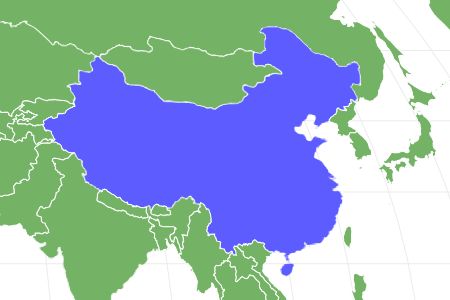Microraptor
Microraptor
Advertisement
Microraptor Scientific Classification
- Kingdom
- Animalia
- Phylum
- Chordata
- Family
- Dromaeosauridae
- Genus
- Microraptor
- Scientific Name
- Microraptor
Read our Complete Guide to Classification of Animals.
Microraptor Conservation Status
Microraptor Facts
View all of the Microraptor images!
Loosely translated from Greek, the Microraptor’s name means “small thief.”
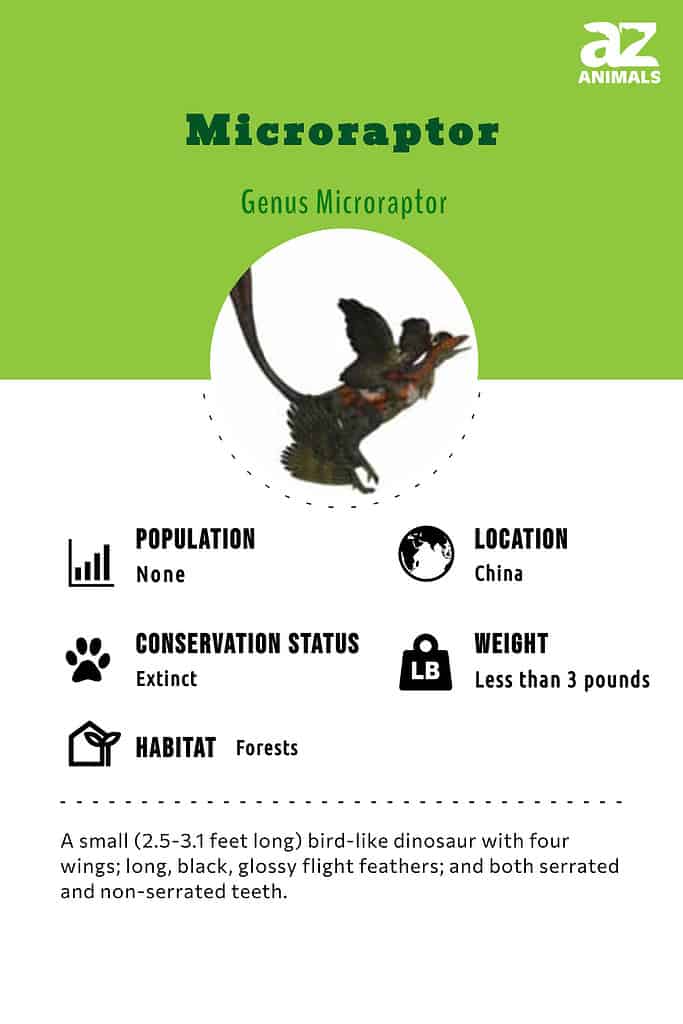
Scientific Classification and Evolution
| Kingdom | Animalia |
| Phylum | Chordata |
| Clade | Dinosauria |
| Clade | Saurischia |
| Clade | Theropoda |
| Family | Dromaeosauridae |
| Genus | Microraptor |
| Species | zhaoianus, hanqingi, gui |
Description and Size
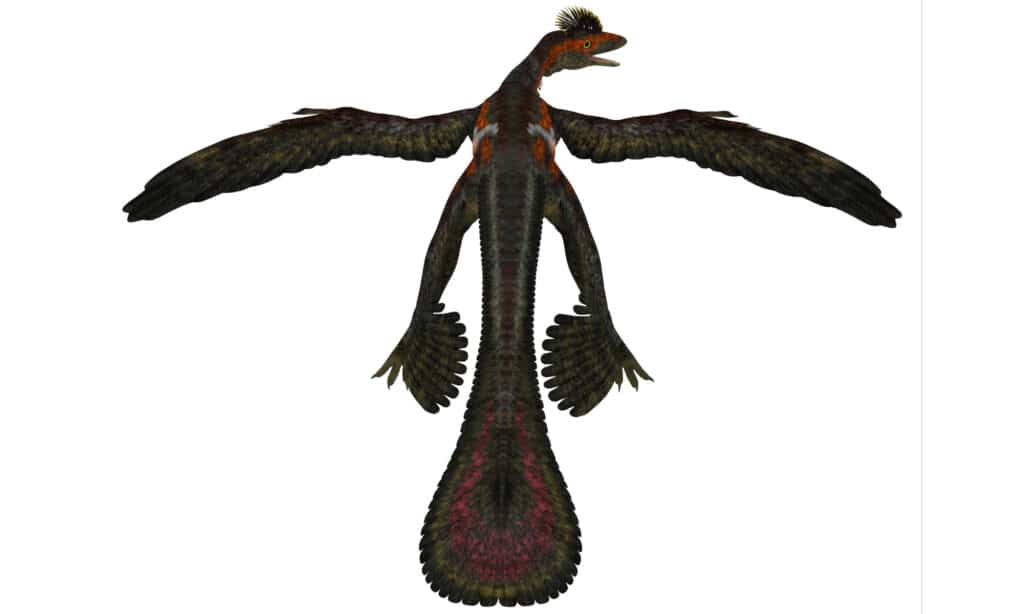
Named after their small size, microraptors were 2-3 feet long and weighed less than 3 pounds.
©iStock.com/CoreyFord
The Microraptor is aptly named due to its small size. Researchers estimate that as an adult, these dinosaurs measured only about 2.5-3.1 feet long and weighed less than three pounds (1kg) on average. This makes them the smallest raptor dinosaurs ever discovered. In fact, it is the smallest of all dinosaurs except for one fossil encased in amber.
In addition to being the smallest, they were also the first non-avian dinosaurs found with impressions of feathers and wings among their fossil remains. Speaking of wings, the Microraptor had four wings and long flight feathers on its wings and legs. Finding dinosaurs with wings and feathers that didn’t actually fly has led many paleontologists to suspect that feathers were not as uncommon in dinosaurs as we once imagined.
Although it is thought that the microraptor did not fly, it probably did glide like a flying squirrel. It would hang out in trees in the forest, then swoop down when it saw prey below.
Researchers have analyzed the pigment cells from fossilized remains of these creatures with special microscopes. Then they compared their findings against modern birds and concluded that the results indicate that most Microraptors were likely black and glossy in color. This glossiness may have been an iridescence like we see in peacocks and hummingbirds.

Initially, scientists believed that microraptors could only glide, though now believe that they could fly to some extent.
©iStock.com/MR1805
Key features of the Microraptor:
- Small size—2-3 feet in length and less than 3 pounds.
- Four wings and long flight feathers
- Serrated and non-serrated teeth
- Black and glossy color
Diet
The small mouth of a Microraptor was filled with a mixture of serrated and non-serrated teeth. This was a feature they shared with some other ancient birds and confirmed that they would have been carnivores.
Based on early findings, the fossil evidence suggested that the Microraptor primarily fed on small birds with which it shared the trees. However, as more fossils were unearthed, a complete skeleton of an Indrasaurus—a genus of small extinct lizards—was discovered in the stomach of a Microraptor. This discovery led researchers to conclude that these bird-like dinosaurs likely fed on lizards, fish, and small mammals in addition to other birds. And also that they were likely opportunistic hunters like many similar-sized dinosaurs.
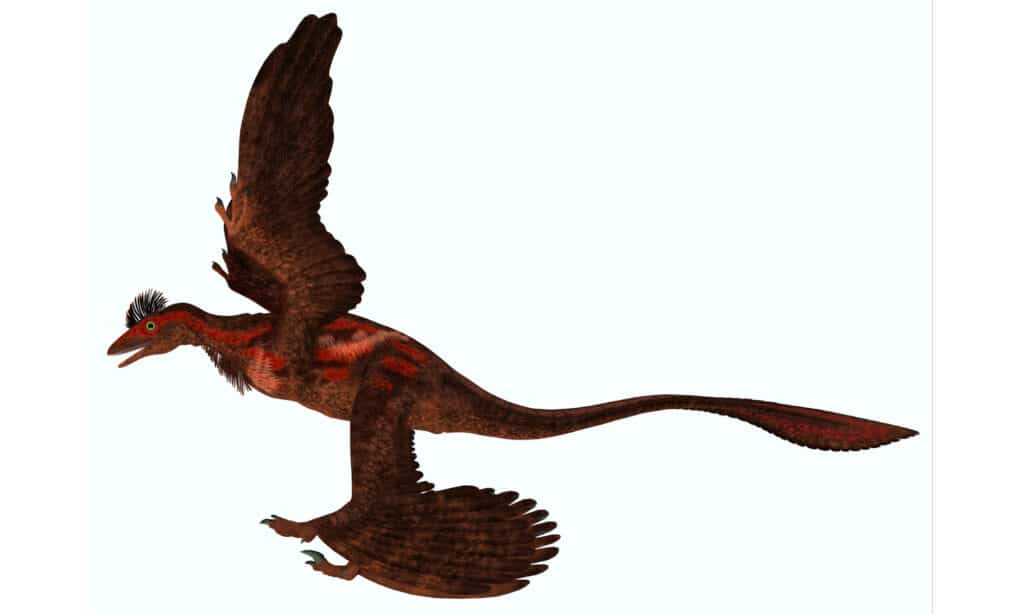
Microraptors had serrated and non-serrated teeth, which indicates that they were carnivores.
©iStock.com/CoreyFord
Habitat
Fossil dating puts the Microraptor in the early Cretaceous period, approximately 125 to 120 million years ago. All of the fossils have been discovered in the Jiufotang Formation in Liaoning, China.
Before becoming a fossil formation, this was an area of forests that were home to many prehistoric birds and other bird-like dinosaurs that shared similarities to the Microraptor.
Threats And Predators
Not a lot is known about what might have preyed on the Microraptor, as none of their remains have been found in other animals. However, given its small size, there would likely have been several other animals that hunted the Microraptor.
For example, the Jidapterus was a genus of azhdarchoid pterodactyloid pterosaur that lived around the same time and may have fed on the Microraptor in the treetops.
In addition to being potential prey for larger animals, the Microraptor would have also competed for food with many other similar-sized species of prehistoric birds. Whether it was small lizards, bugs, or fish, every day would have been a fight for the next meal.
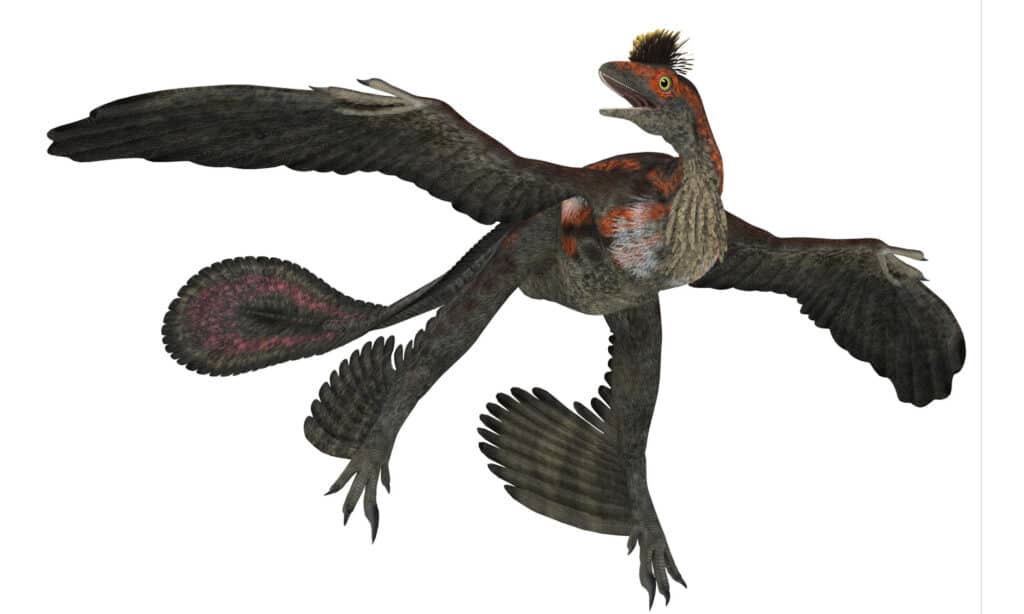
Microraptors would have competed for food with many other similar-sized species of prehistoric birds
©iStock.com/CoreyFord
Discoveries and Fossils
Between 1999 and 2003, there were several controversies surrounding supposed Microraptor specimens—known at the time as the Archaeoraptor. The first specimen was actually a mixture of several different specimens: Microraptor, Yanornis, and a third unnamed specimen. Then for the next couple of years, a couple of other paleontologists were unearthing other specimens in the Jiufotang Formation. Some weren’t preserved great and were missing pieces such as skulls.
Finally, in 2003, Xu Xing was able to analyze around 6 or 7 specimens that showed distinct differences, and he named a new dinosaur: Microraptor gui. Then through further debate, it was accepted that the Microraptor, Microraptor gui, and Cryptovolans were all the same dinosaur—likely at different ages and developmental stages.
Extinction
As with any dinosaur, it’s hard to say what caused their extinction with any certainty. However, there is no indication that the Microraptor went extinct before the mass extinction event at the end of the Cretaceous period, approximately 66 million years ago.
Scientists are unsure of what caused this exactly. Still, many speculate that it was a giant comet or asteroid colliding with the earth. This caused mass changes to the entire planet’s ecosystem and environment. For example, a lingering impact of winter caused photosynthesis to halt among the plants and plankton. This snowball effect led to three-quarters of plants and animals going extinct.
Similar Animals to the Microraptor
Similar dinosaurs to the Microraptor include:
- Archaeopteryx: The initial discovery of an archaeopteryx specimen was in the early 1860s in Germany. This magnificent creature was considered the beginning of the bird’s evolutionary chain for many years. Since then, other birds and bird-like dinosaurs have been discovered that date back earlier. As far as scientists can tell, the Microraptor shared several characteristics with the Archaeopteryx, such as its black color and the large tail plumes.
- Anchiornis Huxley: This bird-like dinosaur was similar to the Microraptor in many ways as far as its diet, where it lived, and size. Although, it was slightly smaller—about the size of a crow. It lived around 40 million years before the Microraptor as well.
- Velociraptor: Real Velociraptors did not look like those in the movies. In fact, they were likely covered in feathers, just like the Microraptor. They were also much larger than their relatives, measuring an average length of 6 feet (1.8 meters) and weighing around 100 pounds (45 kilograms). While they were separated by millions of years and many differences, they were still close relatives.
Microraptor FAQs (Frequently Asked Questions)
When did microraptors live?
According to several hundred different specimens, the fossil dating puts the Microraptor in the early Cretaceous period, approximately 125 to 120 million years ago.
How big was the microraptor?
Scientists estimate that the Microraptor would have been 2 to 3 feet long and typically weighed less than 3 pounds, according to recovered specimens.
Could the microraptor fly?
Originally it was thought that the Microraptor could only glide through treetops from branch to branch. However, after further research, some scientists suspect that the Microraptor would have had some limited flight capabilities.
Thank you for reading! Have some feedback for us? Contact the AZ Animals editorial team.
Sources
- Smithsonian Magazine, Available here: https://www.smithsonianmag.com/science-nature/microraptor-was-a-glossy-dinosaur-119691559/
- Britannica, Available here: https://www.britannica.com/animal/feathered-dinosaur#ref1108132
- Science Org, Available here: https://www.science.org/doi/10.1126/science.1213780?adobe_mc=MCMID=66858363968135884842557727371075567625|MCORGID=242B6472541199F70A4C98A6@AdobeOrg|TS=1654644491

